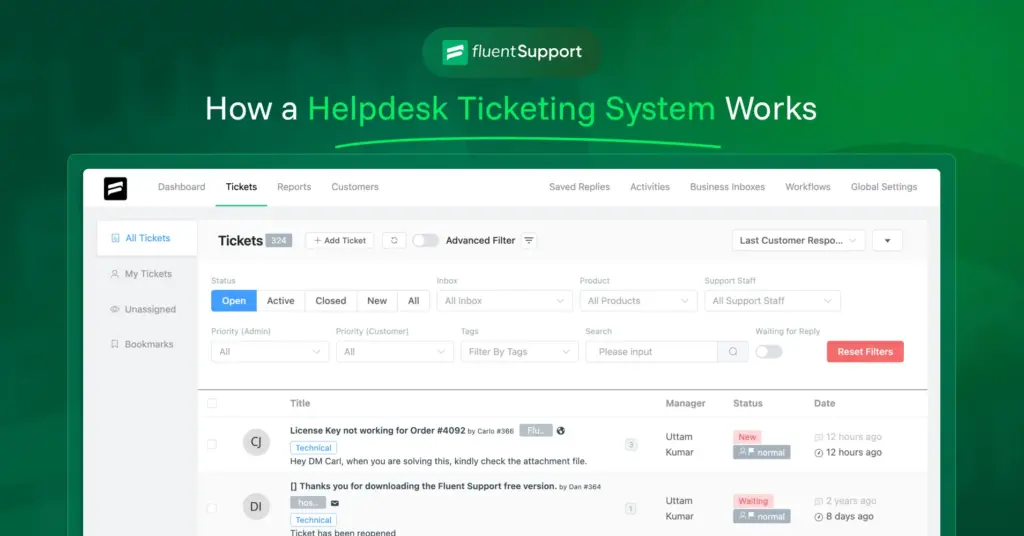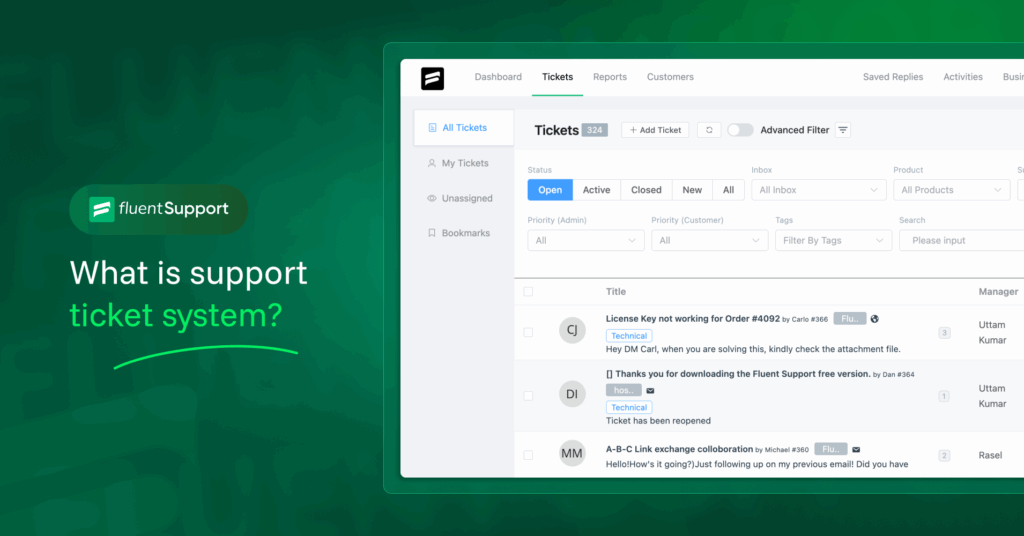
What is Customer Service: From Interactions to Relationships
By Md. Ariful Basher
July 11, 2024
Last Modified: November 20, 2025
What is customer service? It’s a term we hear a lot, but we tend to mix it up with customer support, customer success, customer experience, and so on. It has a different set of checklists, considerations, and approaches.
But customer service is more than just a checklist of tasks. At its core, it’s about fostering positive relationships with customers. It’s about understanding their needs, addressing their concerns promptly and efficiently, and creating an overall experience that makes them feel valued.
In this article, we will do a deep dive into it. Let’s start from the top, from the basics.
What is customer service?
Customer service is the support and assistance a company provides to its customers before, during, and after a purchase to ensure a positive experience.
Customer service agents’ main responsibility is positive customer interactions, encompassing everything from answering questions and resolving confusion to offering helpful advice for better customer experience.
In simple words, it includes a wide range of tasks to meet customer needs proactively, address concerns, and convert customers to satisfied and loyal customers.
Key aspects of customer service
Customer service agents have some primary characteristics that define them in the customer service team.
Customer Interaction
The customer service team directly communicates with the customer. Customer service agents have skills like active listening, empathy, patience, and a detailed understanding of the company’s products and services.
These interactions can occur through omnichannels, including phone, email, live chat, social media, and in-person.
Customer Experience
The customer experience is directly linked to the quality of customer service. A positive experience can build customer loyalty and reduce customer churn. Big companies nowadays compete on the quality of their customer experience in a saturated market.
Big companies nowadays compete on the quality of their customer experience in a saturated market.
Technology Integration
Modern customer service adapts new technologies to enhance efficiency and effectiveness. Customer Relationship Management (CRM) software, AI and automation, chatbots, and robust data platforms are tools for fluidized customer interaction.
As service trends move forward, these technologies allow personalized service and help companies handle increased customer service tickets without losing quality.
Measuring and Improving Service
To continuously improve customer service, companies track various customer metrics such as customer satisfaction scores (CSAT), net promoter scores (NPS), and customer effort scores (CES). These numbers give you granular insights. With these, you can figure out the strengths and weaknesses of the given service and help you improve point by point.
The Many Hats of Customer Service
Customer service agents play different roles at different touch-points on the customer journey map. Here are a few responsibilities a service team has to go through.
Problem-solver
Customer service representatives are the frontline troubleshooters. They look after the first layer of issues raised by customers. Whether it’s a purchase issue or the best package to choose to use of the product, they actively help out clients.
So they have to think quickly, be technically sound, and be calm under stress. Because of direct customer interaction, they are one of the vital bodies to request new features for the dev team.
Informative guides
They are the face of the company to the customers. So they have to provide clear and concise information about products, services, and policies. They answer questions, recommend, and ensure detailed information is provided to the customers before making the purchase decision.
Active listeners
The vital skill of a customer service agent is listening rather than speaking. Reps who are experts on active listening can understand the root cause of customer concerns, empathize with frustrations, and deliver a good customized service.
Active listening is paying full attention to the customer without interception, recognizing their emotions, and creating a feedback loop aiming to provide a solution. This makes customers feel heard and valued.
Relationship builders
A customer service rep’s other job is to connect with customers on a personal level. Personal connections create brand loyalty and customer retention. Relationship building creates a memorable experience that makes customers feel appreciated. Hence, they become an advocate, an unpaid affiliate.
Why Customer Service Matters
The market is getting saturated day by day. Only exceptional customer service can set you apart from your competitors. This can add a lot of nontangible but vital value to your business.
Customer satisfaction and loyalty
A good customer service experience can create happy customers. They are more likely to return and also recommend your business to others. The Salesforce survey found that 73% of customers expect companies to understand their needs and expectations.
Moreover, satisfied customers often become brand advocates without a pannuy. They happily share their positive experiences on social media and with other customers, which increases the brand’s visibility.
Brand reputation
Word-of-mouth marketing is the most powerful way to convert. Customer service interactions play a major role in shaping brand perception. A positive experience with a brand can influence their purchase decision.
Reduced customer churn
Retaining existing customers is significantly cheaper than acquiring new ones. If you can mitigate customer concerns effectively, you can minimize customer churn. A study by Harvard University says if you can increase customer retention rates by 5%, you can increase profits by 25% to 95%.
Reducing churn not only stabilizes revenue but also allows businesses to build long-term relationships with their customers. This can open doors for upselling and cross-selling.
The Future of Customer Service
The world of customer service is constantly evolving. Technology is playing the main role, with chatbots, automation, and AI-powered solutions.
The future lies in striking a balance between automation and human interaction.
AI-powered chatbots can answer frequently asked questions and provide basic troubleshooting steps. These bots even schedule appointments, freeing up human reps from recurring inquiries. Chatbots can operate 24/7, providing immediate assistance and improving first response time. That means the Sun model will not effect your multinational business.
Self-service portals empower customers to find information, track orders, and manage accounts on their own. This reduces the need for direct contact with customer service.
These portals often include comprehensive FAQs, how-to guides, a knowledge base, and community forums where customers can help each other. This not only reduces the workload on customer service teams but also builds confidence in your customers
A ticket management system can help the service team get customer queries into an organized system with a high level of communication functionality. These systems help you organize all customer tickets with a personal agent-only note.
These systems are equipped with high level automation and trained AI power to make service easy and fully intuitive.
But while these tools can streamline processes and enhance efficiency, the human touch will always remain the same. Customers still value the ability to interact with a real person who can understand their specific needs and provide personalized solutions.
Personal interactions can address unique or complex issues that automated systems might not handle effectively. And as we mentioned, empathy makes loyalty.
Building a Customer-Centric Culture:
Creating a customer-centric culture goes beyond building a customer service team. It requires a company-wide commitment to prioritizing customer satisfaction. This can involve:
Empowering employees to make decisions and take ownership of customer issues. An empowered agent feels more confident and motivated to provide excellent service. This can involve giving them the authority to make exceptions, offer discounts, or customize the plan.
Investing in ongoing training to make sure the customer service team has the skills and knowledge to handle any situation. Trainings can improve communication techniques, give sound information about products, and help build strategies to deal with difficult situations.
Gathering customer feedback through surveys, reviews, and social media monitoring to identify areas for improvement. As we mentioned, a proper feedback loop helps businesses understand customer pain points and solve them.
This information can be used to make big data. Ultimately, it will help you improve the products, services, and CX.
Recognizing and rewarding employees who consistently get a good customer rating. Recognition can boost productivity and build a culture of excellence. The rewards can be a bonus, acknowledgment, or better opportunities for career advancement.
Wrapping up
When businesses focus on putting customers first, they make customer service a core part of their business. Therefore, they get more and more happy customers, who keep coming back and even bring in new customers.
A customer-first approach also makes customers loyal. As a result, it helps the brand stand out in a busy market. This gives the business an edge over competitors and makes the business sustainable.
Customer service is not only about resolving issues but also about creating opportunities for upselling and cross-selling. So, a customer service team with the right tools and training is essential. This is the only way to see that upright graph.
Start off with a powerful ticketing system that delivers smooth collaboration right out of the box.












Leave a Reply